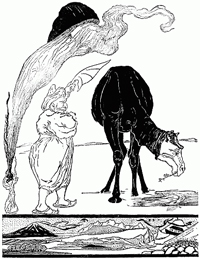
Source: Just So Stories, Joseph Gleason, Project Gutenberg
Using context is the second of three strategies you can use to determine the meanings of unknown words. In Understand New Vocabulary Using Roots and Affixes, you learned how to look inside a word and determine its meaning based on some known parts like “un-,” “pre-,” and “semi-.” The focus in this lesson will be to look outside the word. Review all three strategies below:
- Look inside the unknown word at word parts you know.
- Look outside in the sentence or other sentences surrounding the unknown word.
- Look up the unknown word in a dictionary or other reference book.
Looking outside to find the meaning of an unknown word is easy. Most writers add clues for difficult words in the neighboring words and phrases. When you bump into an unfamiliar word, stop and reread the sentence containing the word. If there are no clues in that sentence, search for hints about the word’s meaning in the sentences before and after the word. When you locate a context clue, guess the word’s meaning using the clue, and then substitute your guess in place of the unfamiliar word to see if it makes sense. If it does, continue reading. If not, you may need to use another resource like a glossary or dictionary to discover an unfamiliar word’s meaning.
Here’s how it works with our tale. Remember my little description of the story in the text above?

Source: Camels in front of the tombs in Petra, Jordon, Poco a poco, Wikimedia
“How the Camel Got His Hump” by Rudyard Kipling is the story of an animal that doesn’t want to work at all, neither hard nor smart. You will discover how a djinni, or genie, outsmarts this idle creature.
You might not know the word “djinni,” but it is explained in the context immediately following the word. Now you can substitute “genie” each time you read “djinni.” Suppose also that the word “idle” baffles you. There are no clues to its meaning in the sentence containing the word. In the previous sentence, you learn that the camel “doesn’t want to work at all.” Someone who doesn’t want to work at all is lazy. You can substitute “lazy” for “idle” and continue reading.
In the beginning of his unflattering account, Kipling identifies the camel as a “howler.” Listen to see if you agree.

Source: Camel Sound, gggy1004, YouTube
In the beginning of years, when the world was so new and all, and the animals were just beginning to work for man, there was a camel, and he lived in the middle of a Howling Desert because he did not want to work; and besides, he was a howler himself. So he ate sticks and thorns and tamarisks and milkweed and prickles. When anybody spoke to the idle animal, he just said, “Humph.”
In the second sentence, the author lists items in the camel’s diet. The list includes tamarisks. If you are not familiar with tamarisks, you can use context clues to infer, or make a reasonable guess, about its properties. In each pair below, select the property that matches your guess about what a tamarisk is.

While you may not be absolutely sure what tamarisks are, you can get over the hump and continue reading.